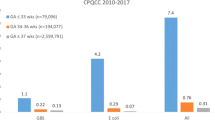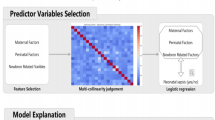Abstract
Objectives
Investigate characteristics of term infants culture-evaluated for early-onset sepsis (EOS) in neonatal intensive care units (NICUs), frequencies of organisms causing EOS, and factors associated with EOS.
Study design
Using a cohort design, we identified term infants evaluated for EOS with blood, cerebrospinal fluid, or urine cultures in 326 NICUs (2011–2016). Using multivariable logistic regression, we investigated the association between EOS and demographic characteristics.
Results
Of 142,410 infants, 1197 (0.8%) had EOS, most commonly caused by group B Streptococcus (GBS; 40.6%). Lower EOS risk was associated with low Apgar score, Cesarean delivery, small for gestational age, prenatal antibiotic exposure, and positive or unknown maternal GBS screening result. Increased risk was associated with prolonged rupture of membranes, maternal age <19 years, vasopressor treatment, and ventilator support.
Conclusion(s)
GBS was the most frequent cause of EOS. Early risk factor recognition may help daily management of term infants in NICUs.
This is a preview of subscription content, access via your institution
Access options
Subscribe to this journal
Receive 12 print issues and online access
$259.00 per year
only $21.58 per issue
Buy this article
- Purchase on SpringerLink
- Instant access to full article PDF
Prices may be subject to local taxes which are calculated during checkout

Similar content being viewed by others
References
The United Nations Children’s Fund (UNICEF). The neonatal period is the most vulnerable time for a child. 2018. https://data.unicef.org/topic/child-survival/neonatal-mortality/. Accessed 7 Apr 2020.
Kuzniewicz MW, Puopolo KM, Fischer A, Walsh EM, Li S, Newman TB, et al. A quantitative, risk-based approach to the management of neonatal early-onset sepsis. JAMA Pediatr. 2017;171:365–71.
Ohlsson A, Shah VS. Intrapartum antibiotics for known maternal Group B streptococcal colonization. Cochrane Database Syst Rev. 2014:CD007467.
Stoll BJ, Hansen NI, Sanchez PJ, Faix RG, Poindexter BB, Van Meurs KP, et al. Early onset neonatal sepsis: the burden of group B Streptococcal and E. coli disease continues. Pediatrics. 2011;127:817–26.
Kuzniewicz MW, Walsh EM, Li S, Fischer A, Escobar GJ. Development and implementation of an early-onset sepsis calculator to guide antibiotic management in late preterm and term neonates. Jt Comm J Qual Patient Saf. 2016;42:232–9.
Ray JG, Urquia ML, Berger H, Vermeulen MJ. Maternal and neonatal separation and mortality associated with concurrent admissions to intensive care units. CMAJ. 2012;184:E956–62.
Warren S, Garcia M, Hankins C. Impact of neonatal early-onset sepsis calculator on antibiotic use within two tertiary healthcare centers. J Perinatol. 2017;37:394–7.
Puopolo KM, Draper D, Wi S, Newman TB, Zupancic J, Lieberman E, et al. Estimating the probability of neonatal early-onset infection on the basis of maternal risk factors. Pediatrics. 2011;128:1155–63.
Dhudasia MB, Mukhopadhyay S, Puopolo KM. Implementation of the sepsis risk calculator at an academic birth hospital. Hosp Pediatr. 2018;8:243–50.
Beavers JB, Bai S, Perry J, Simpson J, Peeples S. Implementation and evaluation of the early-onset sepsis risk calculator in a high-risk university nursery. Clin Pediatr. 2018;57:1080–5.
Singh T, Barnes EH, Isaacs D. Australian Study Group for neonatal infections. Early-onset neonatal infections in Australia and New Zealand, 2002–2012. Arch Dis Child Fetal Neonatal Ed. 2018;104:F248–52.
Sgro M, Shah PS, Campbell D, Tenuta A, Shivananda S, Lee SK, et al. Early-onset neonatal sepsis: rate and organism pattern between 2003 and 2008. J Perinatol. 2011;31:794–8.
Hornik CP, Fort P, Clark RH, Watt K, Benjamin DK Jr, Smith PB, et al. Early and late onset sepsis in very-low-birth-weight infants from a large group of neonatal intensive care units. Early Hum Dev. 2012;88:S69–74.
Stoll BJ, Puopolo KM, Hansen NI, Sánchez PJ, Bell EF, Carlo WA, et al. Early-onset neonatal sepsis 2015 to 2017, the rise of Escherichia coli, and the need for novel prevention strategies. JAMA Pediatr. 2020;174:e200593.
Cailes B, Kortsalioudaki C, Buttery J, Pattnayak S, Greenough A, Matthes J, et al. Epidemiology of UK neonatal infections: the neonIN infection surveillance network. Arch Dis Child Fetal Neonatal Ed. 2018;103:547–53.
Brown AP, Denison FC. Selective or universal screening for GBS in pregnancy (review). Early Hum Dev. 2018;126:18–22.
Escobar GJ, Puopolo KM, Wi S, Turk BJ, Kuzniewicz MW, Walsh EM, et al. Stratification of risk of early-onset sepsis in newborns ≥34 weeks’ gestation. Pediatrics. 2014;133:30–6.
Mukhopadhyay S, Eichenwald EC, Puopolo KM. Neonatal early-onset sepsis evaluations among well-appearing infants: projected impact of changes in CDC GBS guidelines. J Perinatol. 2013;33:198–205.
Lin CY, Hsu CH, Huang FY, Chang JH, Hung HY, Kao HA, et al. The changing face of early-onset neonatal sepsis after the implementation of a maternal group B Streptococcus screening and intrapartum prophylaxis policy-a study in one medical center. Pediatr Neonatol. 2011;52:78–84.
Schrag SJ, Farley MM, Petit S, Reingold A, Weston EJ, Pondo T, et al. Epidemiology of invasive early-onset neonatal sepsis, 2005 to 2014. Pediatrics. 2016;138:e20162013. https://doi.org/10.1542/peds.2016-2013.
Nielsen M, Sheikh N, Fitzgerald E, Meehan M, LeBlanc D, Eogan M, et al. Screening for early-onset invasive group B Streptococcal disease in neonates in an Irish hospital (2001–2014): a retrospective audit. Infect Dis. 2017;49:466–70.
Weston EJ, Pondo T, Lewis MM, Martell-Cleary P, Morin C, Jewell B, et al. The burden of invasive early-onset neonatal sepsis in the United States, 2005–2008. Pediatr Infect Dis J. 2011;30:937–41.
Van Dyke MK, Phares CR, Lynfield R, Thomas AR, Arnold KE, Craig AS, et al. Evaluation of universal antenatal screening for group B streptococcus. N Engl J Med. 2009;360:2626–36.
Bandyopadhyay T, Kumar A, Saili A, Randhawa VS. Distribution, antimicrobial resistance and predictors of mortality in neonatal sepsis. J Neonatal Perinat Med. 2018;11:145–53.
Garcia-Prats JA. Prevention and management of meconium aspiration syndrome. UpToDate®; 2019. https://www.uptodate.com/contents/prevention-and-management-of-meconium-aspiration-syndrome. Accessed 7 Apr 2020.
Cohen-Wolkowiez M, Moran C, Benjamin DK, Cotten CM, Clark RH, Benjamin DK Jr., et al. Early and late onset sepsis in late preterm infants. Pediatr Infect Dis J. 2009;28:1052–6.
Acknowledgements
PTN Steering Committee Members: Daniel K. Benjamin Jr., Christoph Hornik, Kanecia Zimmerman, Phyllis Kennel, and Rose Beci, Duke Clinical Research Institute, Durham, NC; Chi Dang Hornik, Duke University Medical Center, Durham, NC; Gregory L. Kearns, Scottsdale, AZ; Matthew Laughon, University of North Carolina at Chapel Hill, Chapel Hill, NC; Ian M. Paul, Penn State College of Medicine, Hershey, PA; Janice Sullivan, University of Louisville, Louisville, KY; Kelly Wade, Children’s Hospital of Philadelphia, Philadelphia, PA; Paula Delmore, Wichita Medical Research and Education Foundation, Wichita, KS. The Eunice Kennedy Shriver National Institute of Child Health and Human Development (NICHD): Perdita Taylor-Zapata and June Lee. The Emmes Company, LLC (Data Coordinating Center): Ravinder Anand, Gaurav Sharma, Gina Simone, Kim Kaneshige, and Lawrence Taylor. PTN Publications Committee: Chaired by Thomas Green, Ann & Robert H. Lurie Children’s Hospital of Chicago, Chicago, IL.
Funding
This work was supported by Duke Clinical Research Institute’s R25 Summer Training in Academic Research (STAR) Program (Grant #5R25HD076475-07).
Author information
Authors and Affiliations
Corresponding author
Ethics declarations
Conflict of interest
PBS reported being a member of Data and Safety Monitoring Board for United Therapeutics and Seelos; funding from NIH-U2C-RFA-OD-16-006. KZ serves as a consultant to industry for pediatric drug development. RGG reported receiving support from industry for research services (https://dcri.org/about-us/conflict-of-interest/). The other authors declare that they have no conflict of interest.
Additional information
Publisher’s note Springer Nature remains neutral with regard to jurisdictional claims in published maps and institutional affiliations.
Rights and permissions
About this article
Cite this article
Polcwiartek, L.B., Smith, P.B., Benjamin, D.K. et al. Early-onset sepsis in term infants admitted to neonatal intensive care units (2011–2016). J Perinatol 41, 157–163 (2021). https://doi.org/10.1038/s41372-020-00860-3
Received:
Revised:
Accepted:
Published:
Issue date:
DOI: https://doi.org/10.1038/s41372-020-00860-3
This article is cited by
-
Association of maternal infections, antibiotic use, and cesarean delivery with the risk of early-onset sepsis: a nationwide population-based study in full-term neonates
BMC Pregnancy and Childbirth (2025)
-
Clinical Characteristics and Fatality Risk Factors for Patients with Listeria monocytogenes Infection: A 12-Year Hospital-Based Study in Xi’an, China
Infectious Diseases and Therapy (2024)
-
Evaluating of neonatal early onset sepsis through lactate and base excess monitoring
Scientific Reports (2023)
-
Azithromycin reduces inflammation-amplified hypoxic–ischemic brain injury in neonatal rats
Pediatric Research (2022)
-
Early-onset sepsis: a cohort study comparing serial clinical observation with laboratory testing
Journal of Perinatology (2021)



